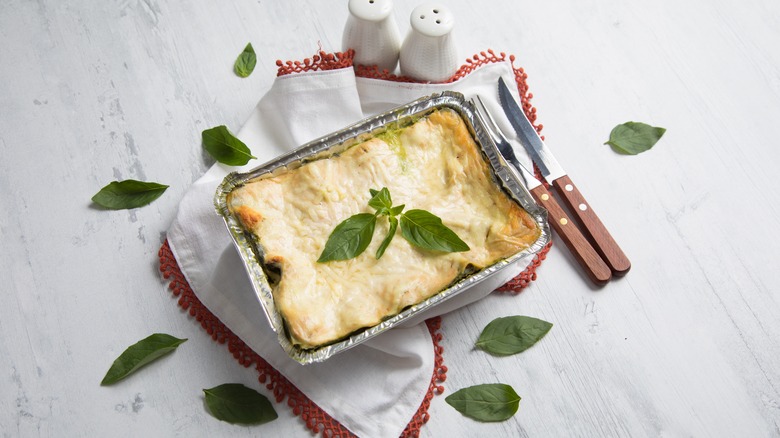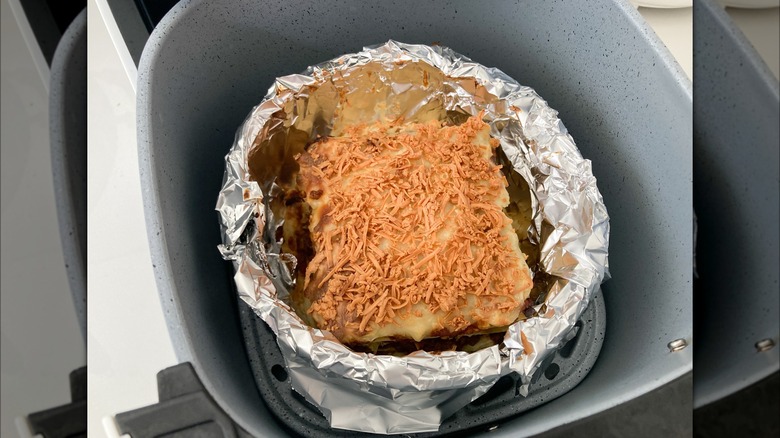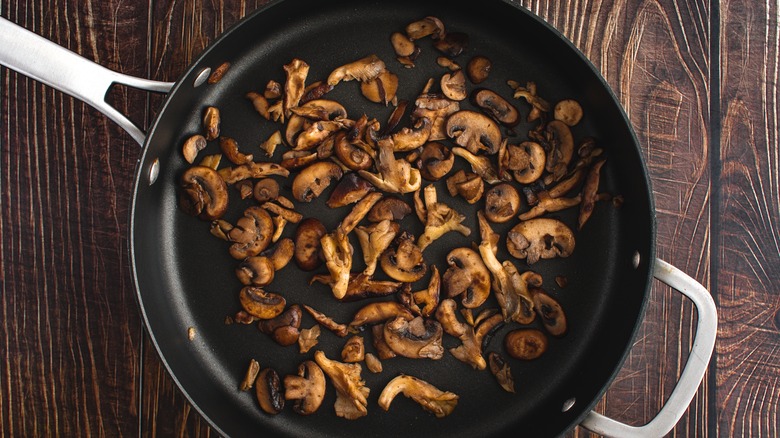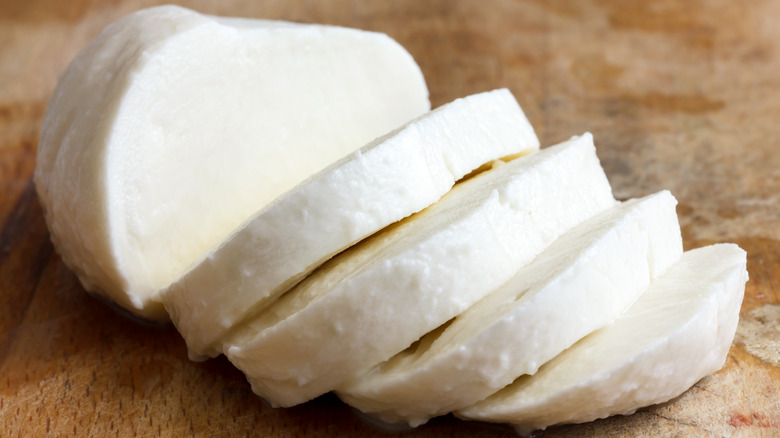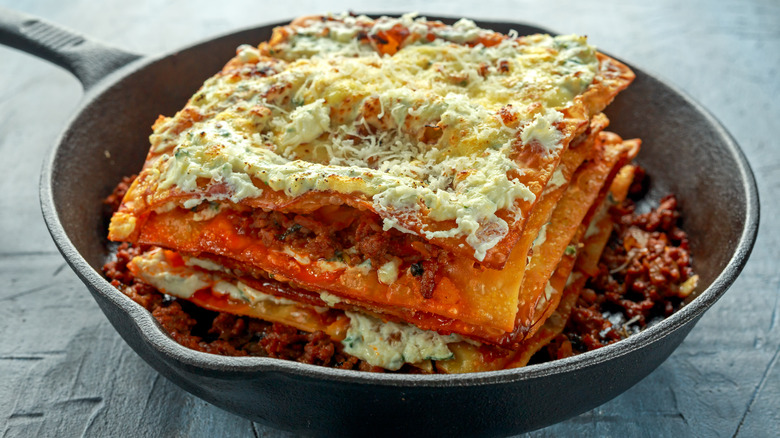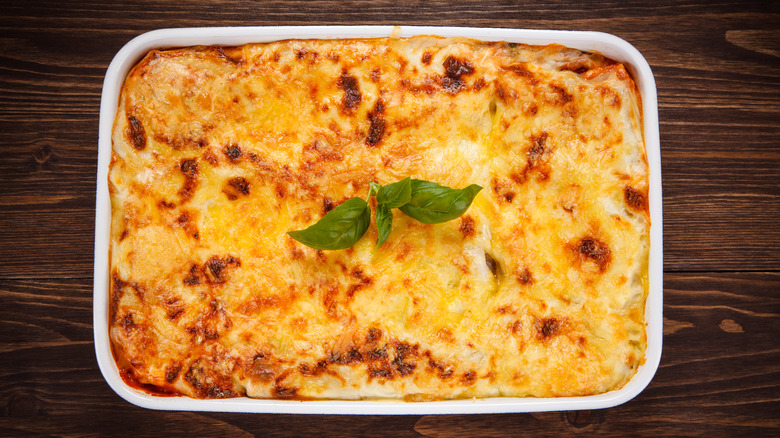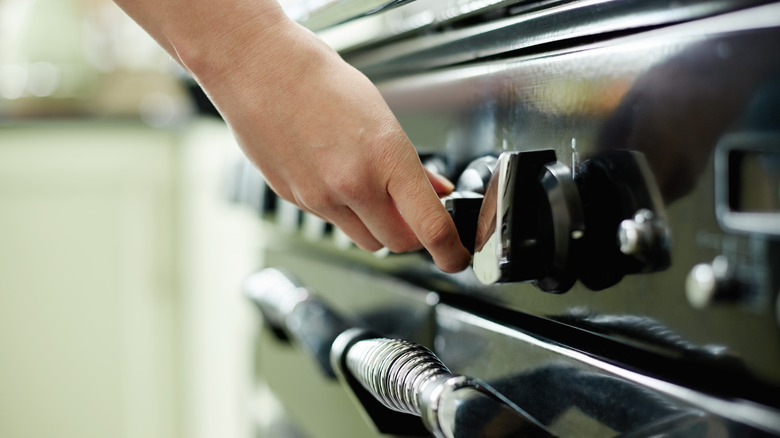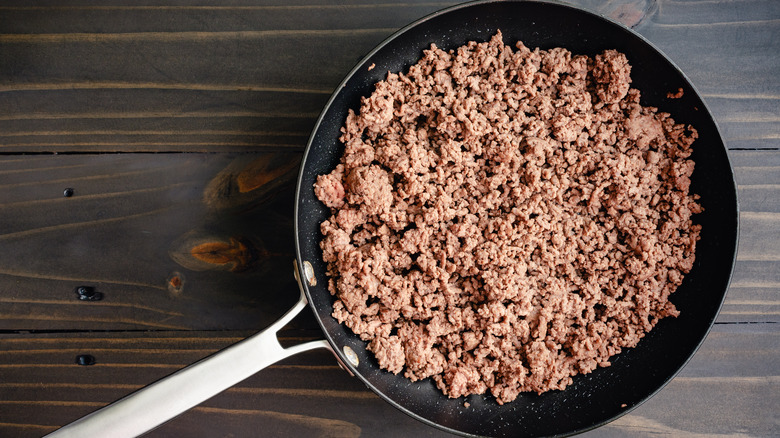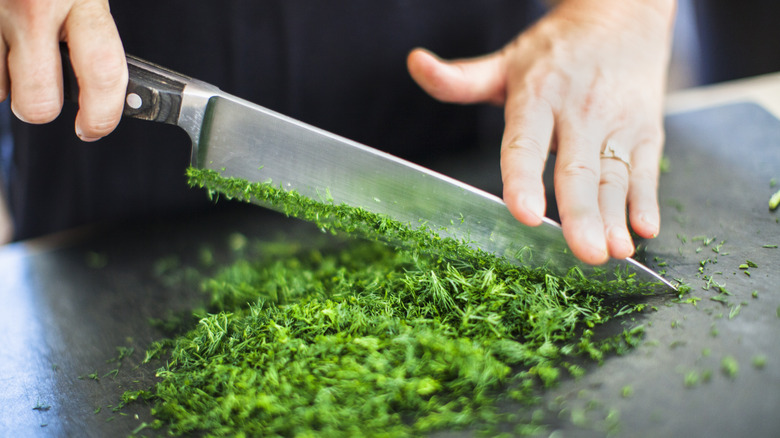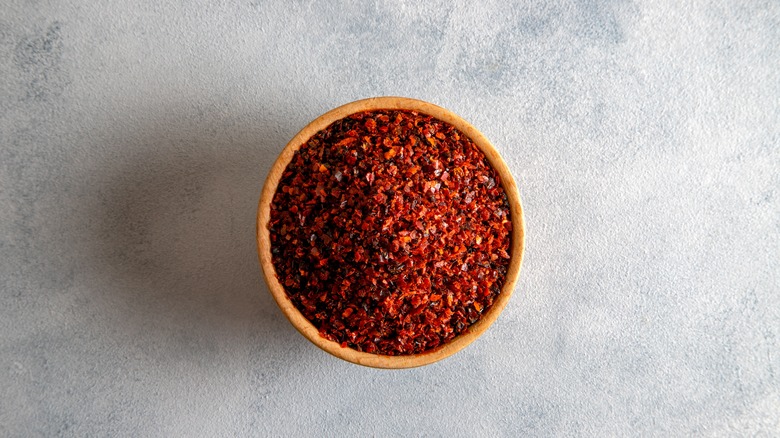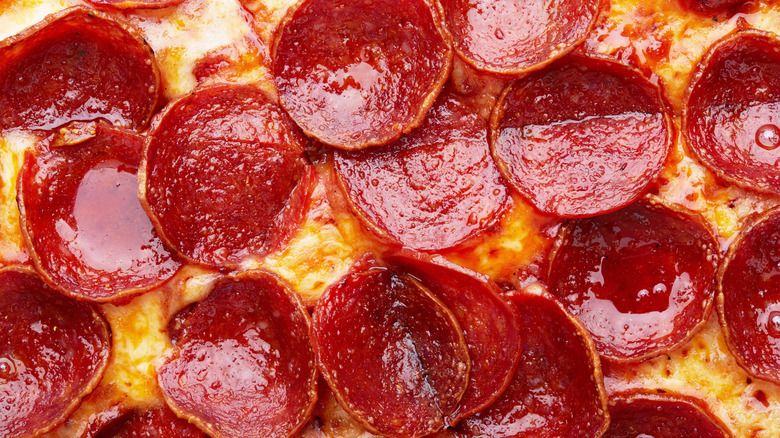11 Ways To Upgrade Your Frozen Lasagna
Frozen lasagnas are as reliable as they come. Whether you're cooking for one or feeding a family, these frozen dinners are tasty, easy to prepare, and can be stored in your freezer for months until you need them. However, while many people are familiar with the ways to make regular lasagna even better with some ingredient swaps, it can be trickier to boost the frozen version. That doesn't mean it can't be done, though. There are loads of ways to boost your frozen lasagna, from adding in extra ingredients to cooking it in innovative ways.
It may seem tricky to add new ingredients to frozen lasagna, but by topping it with extra cheese or spices or sliding additions into it when semi-cooked, you can bulk it out and introduce brand new flavors to it. It's also surprisingly easy to cook it in an entirely different vessel, and you can even cook it twice to give it a completely new texture. Even simple changes, like throwing up the heat while you cook it, can improve it in surprisingly dramatic ways. With these upgrades, you'll feel like you made your lasagna from scratch.
1. Air fry your lasagna for extra crispiness
Frozen lasagna, as we all know, is typically cooked in the oven or microwave. While these are tried and tested methods for making it, they tend to produce the same boring result each time, and each of them has their downsides. Oven-cooked frozen lasagna can take a long time, while microwaved frozen lasagna can be sloppy, colorless, and unevenly-heated.
Avoid both of these possibilities by busting out your air fryer. Stovetop air fryers can cook frozen lasagnas in way less time than your oven would, and even bigger trays of the pasta (like Costco's Kirkland frozen lasagna) can be cooked in them, provided that your air fryer is big enough. The convection technology of your air fryer, meanwhile — that's fancy talk for "the really hot, quick air moving through it" — will brown your lasagna beautifully, giving it an added crispiness that your microwave could never achieve. Cranking up the temperature at the end can give it even more crunch on its surface and a deeper color than you'd get in the oven.
2. Sprinkle on some cinnamon
Lasagna tends to be made with the same ingredients again and again, and when it comes to frozen lasagna things tend not to vary too much between brands. One way to quickly distinguish your frozen pie is to sprinkle a little cinnamon on top. Cinnamon is the warm, aromatic ingredient that boosts lasagna enormously, and while it's usually added to the béchamel sauce that goes inside the dish, you can sprinkle it on top of the frozen version for a similar result. It'll still add its gentle heat and fragrant scent, but from the outside in.
Be wary when you're adding your cinnamon, though. A little goes a long way, and because you're not able to distribute it through the sauce as you normally would, you run the risk of it completely dominating the lasagna's flavor. It's best to lightly sprinkle it evenly across the top of the lasagna about halfway through the cooking process, so that you give the spice a chance to cook off slightly in the oven. If you don't like cinnamon, using nutmeg can have a similar effect, giving your lasagna a woody, nutty edge.
3. Sneak some veggies into the lasagna
Frozen lasagna tends to be pretty low on veggies, and if they are in it they're usually mushy and bland. This isn't a dealbreaker for most people — frozen lasagna usually isn't bought as a healthy option, after all – but there are times where we crave a bit more freshness from this dish. Luckily, you can pop veggies into it pretty easily. As it's cooking, sauté some of your favorite vegetables; mushrooms, bell peppers, zucchini, and carrots will all go particularly well in the dish. Then, once the lasagna's about three-quarters of the way done, pull it out of the oven and tuck your vegetables in. You can do this by either slotting them in around the lasagna, or gently peeling back the top layer of pasta and tucking them in.
Alternatively, you can add vegetables before your lasagna even starts cooking. Take your frozen lasagna and pop it out of its tray; it should come out in one big, frozen block, provided that it hasn't started thawing. Take some sliced vegetables, and place them in the bottom of the tray, before putting the frozen lasagna block back on top and cooking as normal. As the lasagna cooks, so will the vegetables. Just make sure you don't pile them up too high or you risk everything spilling over the sides as it cooks.
4. Top your lasagna with new cheese
Frozen lasagnas are usually topped with a thin, unsatisfying layer of mozzarella cheese that doesn't exactly sing with flavor. Luckily, this layer of cheese is fairly easy to replace with a better alternative. Before you throw it in the oven, scrape off the mozzarella pieces on top, and replace them with your own grated or fresh mozzarella. Depending on how long your lasagna is meant to cook for, you may want to do this once it's already partially-cooked so that it doesn't burn. By using a fresh, high-quality mozzarella, you can give your lasagna a more luxurious flavor, and avoid that plasticky taste that cheaper cheese often has.
Don't forget that you can use other cheeses on your mozzarella, too. There are a lot of underrated cheeses that can upgrade lasagna and give it extra tanginess, funkiness, and umami. Instead of using mozzarella, hit it with a little provolone, which will give it a little more sharpness. If you'd normally top your lasagna with Parmesan, try grating on asiago d'allevo as an alternative, an aged asiago that has tart, slightly fruity notes. If you can't get your hands on this cheese, though, parmesan or pecorino will still add loads of flavor.
5. Cook, cool, and fry your frozen lasagna
One of the best methods for improving your lasagna can be performed after it's done cooking. You may not know it, but you can fry your leftover pieces of lasagna to improve their texture. By popping cold slices of lasagna in a hot skillet top-down, you crisp up the outsides and gently caramelize the edges of the pasta and the cheese topping, turning your leftovers into a thing of beauty. The oil you cook it in can also give it an extra smoothness.
If you're worried about your lasagna falling apart in your pan, you shouldn't. When lasagna cools, it congeals slightly, turning into a solid block that lends itself well to frying. Frying your lasagna is also a great opportunity to add in extra flavors: Before you pop it into the pan, you can fry off a little garlic or some chopped chili, imbuing the pasta with some savoriness or piquancy. If you're craving some extra texture, you can even dip your cold lasagna pieces into an egg wash and coat them in breadcrumbs before frying them, which will give them a delightful crunch.
6. Pop it in a different dish
Who said that you have to cook frozen lasagna in the tray that it comes in? By using a different pan to cook it, you can give your dish an entirely new lease of life. Popping out your frozen lasagna and placing it in your own lasagna dish will help with better heat distribution, helping you avoid any cold spots throughout the pie. These pans also have better insulating qualities, which can raise your lasagna to a higher overall temperature, thereby helping the sides and top get firmer and crisper.
You don't have to spend a fortune on a classic lasagna pan to get this result, either. Even relatively cheap pans can help your lasagna bake evenly. Importantly, though, you should look to match up the size of your pan with the size of your lasagna. If you're decanting a single-serve frozen lasagna into a massive dish meant for a bigger pie, it's kinda a waste of space, and just leaves you with more washing up afterward.
7. Crank up the heat
You want to know the quickest, easiest way to improve your lasagna? You just have to heat it up a little more than you think. Frozen lasagnas tend to all cook around the 375- to 400-degree F mark, and while this is reliable and helps them cook through evenly, this can get in the way of maximizing their browning potential. By throwing up the heat a little more than is recommended, you can give yourself a more thoroughly-caramelized top that's developed with more flavor.
You have to be careful about how much you do this, though. Cranking up the heat to a super-high temperature will cause your lasagna to burn on the outside, while remaining undercooked or still frozen on the inside. Furthermore, picking a higher heat from the very beginning of the cooking process may throw off your timings. The best way to approach it is to start your lasagna at the recommended heat, so that it begins to cook through properly, and then crank up the heat towards the end of the cooking process. By blasting it with extra heat in the last 10 to 15 minutes, you'll still get that all-important caramelization without any cold bits inside. You can also broil your lasagna in the last few minutes of its cooking time to give it an even deeper brown surface.
8. Bulk it out with some extra meat
One of the biggest complaints we have about frozen lasagna is that its meat is often nowhere to be seen — and even when it hasn't melted into the sauce, it still somehow manages to be mushy and formless. The solution is to add in some of your own meat to bulk it out and give it extra flavor. By cooking some ground pork or beef beforehand and slotting it in, you boost the lasagna's protein content and make it more filling. You can also use it as an opportunity to season the ground meat with any spices, herbs, or aromatics that you want, which will then flavor your lasagna.
Adding it in can be tricky, though, so be careful. To do so, you'll need to lift the top layer or layers of your lasagna, and spoon your cooked meat in. Do this slowly, so that you don't smear any of the lasagna's ingredients off-center and ruin its end result. This may also be easier to do when individual-portion lasagnas instead of large ones, as pulling back the sheets can be a little cumbersome.
9. Scatter on some herbs
Frozen lasagnas tend to be light on herbal flavors, and when they're present they're often a little metallic and flat, due to sitting in the freezer for a while. Using your own herbs can rectify this and give your lasagna a much-needed flavor and visual lift. Just grab a bunch of fresh herbs, slice them up, and pop them on top of your lasagna before serving. We prefer to use basil or parsley on our frozen lasagnas. Parsley has an earthy, zesty taste that offsets the deep flavors of meat, cheese, and tomato sauce well, while basil has a fruitiness and a moreish, fragrant smell.
You don't even need to use fresh herbs, either. A quick sprinkling of dried oregano or basil can give your lasagna a quick boost of freshness and increase its aromatic qualities. If you're using either (or any other dried herb, for that matter), it can be a good idea to crush them gently between your fingers and thumb before you scatter them on so they distribute across the top of your lasagna better.
10. Dust it with some chili flakes
Frozen lasagnas are intended to be enjoyed by the whole family, and as a result they don't tend to do anything too wild with their flavor. This means that heat isn't high on the agenda in these frozen dinners — but with some chili flakes, you can quickly add some all-important spice. Dust some chili flakes on top of your lasagna a few minutes before you serve it, giving its warmth time to gently soften them. The heat won't necessarily distribute fully through the lasagna, but with each mouthful, you'll get a pop of gentle heat that will slowly develop as you munch away.
It's worth remembering your ratios here, though. Dried chili flakes are significantly hotter than fresh chilies, and you can assume that a tablespoon of dried flakes is the same heat as about 4 tablespoons of the fresh product. Therefore, it pays not to go overboard, unless you really love spice. If you want to unlock your chili flakes' flavor even more, try frying them gently in a tablespoon of oil before spooning them over the lasagna. This will slightly take the bite out of them, giving you a smoother, warmer spice.
11. Pop on some pepperoni
We hereby give you permission to make your lasagna extra meaty. Pepperoni may not be your first choice for lasagna, but it gives the frozen versions serious depth. The cured meat brings a salty, savory, intense flavor to the pasta dish that offsets the tomato sauce, preventing it from getting too sweet or tart. As you might expect, it also goes seamlessly with the other meat in the dish, and when it's paired with the béchamel sauce in lasagna, its flavor mellows slightly.
Although you can slip pieces of pepperoni into the body of your frozen lasagna, we don't think that's using it to its full potential. Instead, we recommend crowning your lasagna with pepperoni pieces about halfway through the cooking time. As the lasagna cooks, the pepperoni will crisp up just like it does on a pizza. Its flavor will also intensify slightly and will work to better contrast your lasagna's filling and the cheesy notes running through it.
